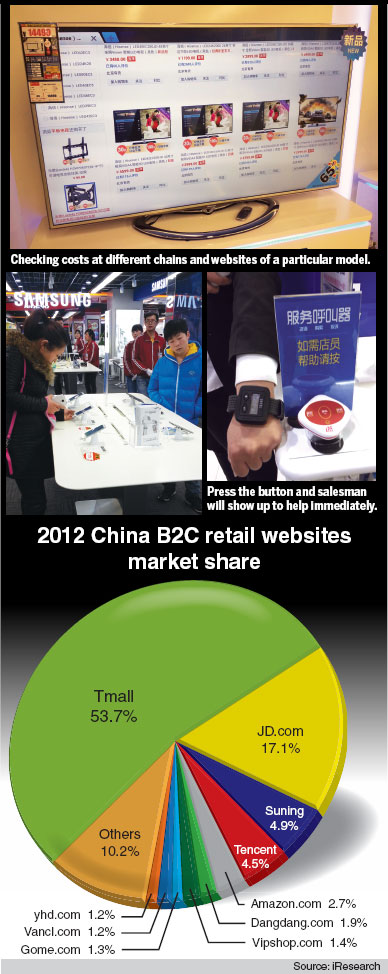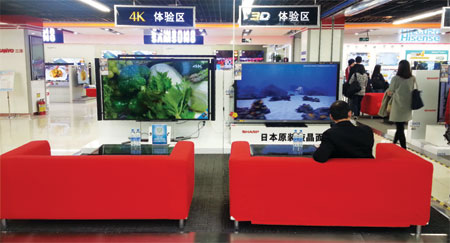Surviving the e-commerce tsunami
Updated: 2013-12-06 06:39
By Emma Dai(HK Edition)
|
|||||||||
Electronic appliance chain store retailers are pitching head-on to offer customers with 'shoppers experience', 'price reductions' and 'new products' to ward off fierce competition from their e-tailing counterparts. Emma Dai reports.
Lean back and relax, watch a movie on your 3-D, 80-inch TV screen or check out the most popular programs online on the latest ultra-high-definition smart TV. You can switch channels from up to 3 meters away without a remote, just clap your hands, snap your fingers. The TV set can read what you want.
This is the latest in high-tech gadgetry on display at the Dazhong Zhongta electronics mall and it's only a fragment. The two-floor home appliance store, with 20,000 square meters, is right in the heart of Beijing, and it is the biggest of its kind in China. The store was officially opened in 2002 by Dazhong Electronics, the company founded by Zhang Dazhong. Gome Electrical Appliances acquired Dazhong in 2007 for 3.6 billion yuan ($591 million). Gome which is listed in Hong Kong is one of the country's biggest electronics chains. Zhang now sits as board chairman of Gome Electrical Appliances.
Zhongta mall which reopened after renovations on July 27, has reported a revenue increase of 25 percent since its reopening, compared to the same period last year. "Revenue at the Zhongta store is expected to rally to 1.2 to 1.4 billion yuan this year and its profit to reach 80 million yuan," says Fang Wei, chief financial officer of Gome.
China's electronic appliance chains seem to have discovered the channel through the reefs and shoals presented by e-commerce, after struggling for almost two years to keep their heads above water.
Gome's trump card is that it offers the "shopping experience." "Online stores can't offer this," says Wang Junzhou, president of Gome. "In this smart technology era, home appliances have become so complicated that they are all able to go online. You can send a message, to your heating system to warm the house before you get home. On a smart TV, you can watch the 7 o'clock news while you're having dinner at 9. It's unlikely customers will buy the new generation products online. They are expensive. You can't see the magic of them on a two dimensional photo. Nonetheless, the high-tech, top of the line products are welcomed in our brick and mortar stores. Very often people come to us for a cheap model and leave with a more sophisticated one. When they compare all the choices, they always want a better one."
How much better and how expensive? The 85-inch TV which switches channels with a wave of the hand costs 249,999 yuan - after a 5,000-yuan discount. "The TV was rolled out this June. It's the latest technology," says the salesman in charge. "In October, we sold four."
Gome focuses on product demonstration in its on-going store upgrades. The store is equipped with broadband Wi-Fi so that all the smart functions can be demonstrated smoothly. Instead of just high-end goods, a whole series of products are exhibited to secure customers all possible choices. Real, operating devices instead of mere models are placed on open counters so shoppers can feel the touch screen and check out the sharpness of photographs taken with the built-in cameras. Buttons on the wall, when pressed, bring the nearest salesman. "We can't expect customers to read 100-pages of instructions," says Wang. "It's much easier to learn from our salesman. They have a strong influence during any purchase."
"Zhongta mall raised the curtain on upgrading," says Fang. "We will use it as a sample to carry out the transformation of all our stores, starting with the flagship stores."
All the efforts aim to fight one competitor - e-commerce, which mushroomed in recent years in China. According to iResearch, an organization following the sector, revenue from e-commerce has grown from 3.6 trillion yuan in 2009 to 8.1 trillion yuan in 2012. In the first three quarters of this year, the cumulative 7.1 trillion yuan is expected to jump to 10.2 trillion yuan by the end of the year and to reach 15 trillion in 2015.
Meanwhile e-tailing has been eroding the territory of traditional retailing. Country-wide, online deals consumed over 6.2 percent of the retail sector revenue last year. According to data from the National Bureau of Statistics of China, the e-tailing market share reached 7.8 percent in the third quarter this year. E-tailing is growing at a rate of 3.2 times faster than the retail sector as a whole. It is expected to exceed 10 percent of the industry aggregate in China in the next three to five years.
Pricing strategies
Established in 2009 by Alibaba Group, the "November 11 Festival" has become the biggest online shopping gala in China. With deep discounts covering a vast number of goods, Taobao Marketplace and Tmall.com, both shopping websites owned by the Alibaba Group, attract more buyers every year. This year alone, deals worth over 35 billion yuan were made during the 24-hour period on Tmall and Taobao. That was up 83 percent from the previous year.
The fever is not solely about Alibaba. Major online retailers, such as JD.com, Tencent and Amazon were all geared up for the game too. JD.com, also known as 360Buy, is the second biggest online retail website in China with a share of 17.1 percent in the B2C market. During its promotion from Nov 1 to 12, its turnover hit 10 billion yuan. Revenue in electronic products grew by five times over last year. According to data released by the company, 1.3 million small household appliances, 163,000 TV sets, 100,000 washing machines, as well as 160,000 computers were sold during the promotion.
"Price is the key," says Wang. "But we are not afraid of a price war. It has never stopped and we always come out the winner." To keep price-sensitive customers happy and margin above standard at the same time, Gome applies separate pricing strategies for different price ranges.
At the lower end, the company offers a lowest-price guarantee. Customers are encouraged to check how much the same model costs at other chains and websites. Computers with "Compare price" sign are placed in obvious locations in the Gome mall. Salesmen will also open up tablet computers and show prices posted online at competitors' sites.
"Whether customers know prices elsewhere, we want to assure them that our offers are the best," says Wang. "They don't need to visit another store to make a decision. That way speeds up purchasing process. If we found something selling at a cheaper price by a competitor, we can offer a discount. Then we don't miss the deal and can negotiate with the supplier later."
According to Gome's study, models on the first two pages of each category count for around 90 percent of deals on mainstream websites. But the same models represent only 25 to 30 percent of revenue in brick and mortar stores. "These are highly standard products such as smartphones and computers," says Wang. "To secure low prices, we need only to focus on overlapping products."
At the higher end however, the scene is different. To improve its profit margin, Gome works with manufacturers on differentiated products, which can be found only at Gome. These include some models of refrigerators and phones from leading brands such as Haier and Samsung, whole series of Sanyo TV sets and Electrolux air conditioners. "It's either the same product with a cheaper price or the same price with a better product," says Wang. "Without competition we are much freer to set prices." Up to the end of September, differentiated products counted for 22 percent of Gome's revenue, compared with lower than 20 percent last year.
Shopping experience
According to its third quarter financial report, Gome's revenue grew 8.03 percent to 41.66 billion yuan compared with the same period last year. Its gross profit margin increased 1.78 percentage points to 18.01 percent, representing a historic high. Net profit was 582 million yuan, a 170.21 percent rally compared with a net loss of 829 million yuan in the same period last year.
"Gome's offline store strategy is entering a more stable time with revenue starting to bounce back from the bottom," says Forrest Chan, analyst of CCB International. "But next year it may not rise as fast, because this year's figure is really based on a very low comparable base."
"Though in the last two years traditional retailers have generally been at a disadvantage, they have adapted fast and repositioned themselves for survival," says Chan. "Pure e-commerce is not perfect. In terms of after-sales service and casting influence on consumers' decisions, offline businesses still have the advantage. Shopping experience is where online retailers can't compete with regular stores. Though nowadays everyone checks prices online, at some stage consumers still visit real stores. As long as retailers can bring down prices, their sales will return."
"Besides, big brands such as Samsung rely on chain stores to promote their new products," he added. "They have show spaces in malls which can demonstrate all the models. It's a part of a retail chains' bargaining chip. When negotiating with suppliers for differentiated models and lower prices, chain stores may even have some advantage over e-tailers because their show room function is irreplaceable."
While changes are made to compete with online retailing, the best way may be fighting fire with fire. Since the boom of e-tailing, brick and mortar retailers have been moving on online.
Suning, another leading electronics appliance retailer with about 1,600 stores across the country, announced its plan to become an e-commerce platform "combining Walmart and Amazon" in February 2012. The Shenzhen-listed company acquired redbaby.com, a website specializing in baby products, for $66 million in September 2012. Once focused exclusively on electronic appliances, Suning website now sells everything from computers to railway tickets. According to iResearch's data, Suning became the third largest B2C website in China last year with a market share of 4.9 percent, after JD.com and Tmall. However, as the company's latest report shows, even with a 10 percent year-to-year increase in revenue during the first three quarters this year, Suning's net profit dived 73.41 percent to 625.49 million yuan.
In contrast, Gome's online plan is much more conservative. "We are looking for a profitable and sustainable model for our online channel," said Gome's Fang. "We are integrating our supply chain, after sales service and developing the logistics network so we can improve operating efficiency and bring down costs. Only when we find the right model will we start to expand our online business. Otherwise the more we sell the more we lose. It's meaningless to attract customers by discounts or buy website traffic from search engines. Customers who come to us in this way are not loyal."
"This year we expect e-commerce to reach 5 percent of our revenue," says Wang. "It's not our priority now. We hope its share can increase to 15 to 20 percent in three years' time."
However, CCB International's Chan pointed out that a company may lose the opportunity if it starts too late to move into e-commerce. "It's too early for Gome to seek profits online at this stage. The gap between Gome and its competitors is huge. While Gome starting late in the online business and it is lagging behind, it will need to sacrifice profits for a year or two to grab market share as quickly as possible. In the future, most online customers will concentrate on one or two big-fish websites only. If one fails to attract a large number of users at the start, it may not survive at the end."
Contact the writer at emmadai@chinadailyhk.com
|
While e-tailing competition hots up, shoppers can get same product with cheaper price or same price with better product in a regular store. |


(HK Edition 12/06/2013 page5)
